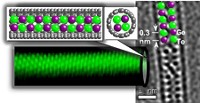Advertisement
Grab your lab coat. Let's get started
Welcome!
Welcome!
Create an account below to get 6 C&EN articles per month, receive newsletters and more - all free.
It seems this is your first time logging in online. Please enter the following information to continue.
As an ACS member you automatically get access to this site. All we need is few more details to create your reading experience.
Not you? Sign in with a different account.
Not you? Sign in with a different account.
ERROR 1
ERROR 1
ERROR 2
ERROR 2
ERROR 2
ERROR 2
ERROR 2
Password and Confirm password must match.
If you have an ACS member number, please enter it here so we can link this account to your membership. (optional)
ERROR 2
ACS values your privacy. By submitting your information, you are gaining access to C&EN and subscribing to our weekly newsletter. We use the information you provide to make your reading experience better, and we will never sell your data to third party members.
People
Nobel Prize In Physics
Awards: Revolutionary optical technologies take this year's honor
by Bethany Halford
October 12, 2009
| A version of this story appeared in
Volume 87, Issue 41
The 2009 Nobel Prize in Physics recognizes two separate achievements in optical technology that have transformed spectroscopy, photography, and communication.
Charles K. Kao, 75, garnered half of the $1.4 million prize “for groundbreaking achievements concerning the transmission of light in fibers for optical communication.” Willard S. Boyle, 85, and George E. Smith, 79, will share the other half of the prize “for the invention of an imaging semiconductor circuit—the CCD sensor,” or charge-coupled device.
A CCD can accumulate light-inducing charges over its metal-oxide semiconductor surface and uses so-called charge bubbles to record images in electronic form. The technology is the basis for digital photography and is at the heart of many spectroscopic instruments.
Boyle and Smith dreamed up the CCD one October day while working at Bell Laboratories, in Murray Hill, N.J., in 1969. During a discussion that took no more than an hour, they sketched out the device’s basic structure and principles of operation. Today, the devices are used in scanners, surveillance satellites, electron microscopes, and most optical spectrometers.
“In spectroscopy, CCDs have provided the ability to view a wide range of wavelengths simultaneously, with unprecedented sensitivity, wide wavelength capabilities, and large dynamic ranges,” notes University of Arizona chemistry professor and instrumentation expert M. Bonner Denton. “Boyle and Smith’s contributions have led to a revolution in optical spectroscopy and electronic imaging. Clearly, they deserve this recognition and honor for their contributions.”
Kao’s award-winning contribution was made in 1966, while he was working at Standard Telecommunication Laboratories, in Harlow, England. There he investigated the fundamental properties of optical fibers with respect to communication, taking into consideration both the physics and materials properties necessary. Ultimately, he determined that optical communication would be possible with very pure glass fibers.
Modern telephone, Internet, and cable television are all possible because of the groundwork Kao laid. According to the Nobel committee, were we to unravel all the glass fibers currently in use, we would a have a single strand long enough to encircle the globe 25,000 times.




Join the conversation
Contact the reporter
Submit a Letter to the Editor for publication
Engage with us on Twitter